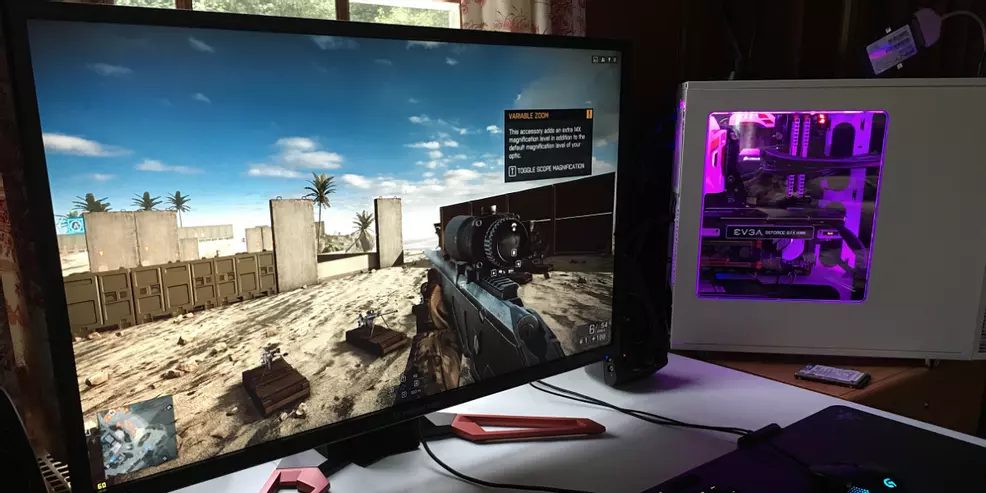Best 4K TVs For PC Gamers
Using a 4K TV as a monitor is an affordable option that might be better than you think.
In years past, using HDTVs as PC displays was something you could do, but the experience typically provided some huge drawbacks compared to conventional monitors. Most TV manufacturers designed and engineered their products to be used for watching movies or reality shows. While some TVs had VGA or DVI inputs and supported basic PC use with special picture modes, barely any attention or care was ever given to the user experience for customers buying those televisions to use as desktop monitors. The lack of attention from manufacturers aside, most TVs offered poor performance when used for web browsing or PC gaming. Poor viewing angles, crippling input lag, and miserable DPI plagued the few PC gamers who craved a larger display for their PCs. Much like American politics, Bruce Jenner, and the number of people who looked up to Bill Cosby, using a TV as a PC gaming display has changed drastically in the last few years.

As little as 5 years ago, 4K TVs were the hottest new technology in consumer electronics. Seen as a savior for the TV manufacturing business after the 3D experiment had mostly fallen flat, 4K was a new technology that would drive people to replace their existing televisions. As with any new advancement in tech, 4K displays arrived at very high prices and served only a small niche at the top of the market. 4K panels made up the overwhelming majority of new TVs on the market for the first half of 2017, and they fit into all price levels. The only new 1080p screens still being sold by major manufacturers serve the ultra low budget market. 4K PC monitors have followed a similar path and are now common at PC hardware retailers. Like their 1080p and 1440p counterparts, 4K PC monitors are available in budget options and in high-end gaming configurations.
4K PC displays are typically available in screen sizes ranging from 24 inches all the way up to the 40 inch variety. The high number of pixels contained in 4K monitors leads to some incredibly high pixel densities, especially on 24 and 27-inch screens. Most PC gamers must resort to using DPI scaling in Windows (or OSX) in order to make on-screen object easier to see. Some apps and games handle this adjustment well and others will respond poorly. It's currently an imperfect solution to a problem that will give pause to buyers considering the move up to 4K. In 32 and 40-inch displays, the pixel density of 4K makes much more sense. A 40-inch 4K display will have a similar DPI measurement to a 27-inch display running at 1440p (110 vs 108), The increase in resolution at the 40-inch size allows for the default 100% DPI scaling in Windows and gives a look that is virtually identical to users coming from a 27-inch 1440p screen. The increase in usable screen real estate for browsing and work is awesome.
To give a baseline for comparison to the new wave of 4K TVs, three of the most popular 4K 60Hz monitors have been selected.
- The ASUS PB287Q is a 28-inch TN panel that has been around for a few years and sells for ~$450. It has a measured 765:1 contrast ratio and input lag around 61ms. Being a TN panel, it offers very poor viewing angles and less than stellar color reproduction, but offers excellent response times.
- The ASUS MG28UQ is a new 28-inch TN panel featuring AMD Freesync Adaptive-Sync that also sells for ~$450. It has a measured 753:1 contrast ratio and input lag around 22ms. While being similar in viewing angle and color performance to the PB287Q, the low input lag and superior build quality make it a better buy for the PC gamer.
- The Acer Predator XB321HK is a 32-inch AHVA panel featuring nVidia’s G-Sync Adaptive-Sync and it sells for ~$1100. It has a measured 982:1 contrast ratio and input lag around 61ms. Unlike the previous TN panels, the XB321HK can reproduce more than 100% of the sRGB color gamut and it has much less brightness and color degradation at extreme angles.
Today’s look at 4K TVs suitable for PC gaming use includes 3 HDR-capable 60Hz models, with 2 of them being from the same series.

- The Samsung UN40MU6300 is a 40-inch VA panel and has no adaptive-sync capability. It typically sells for ~$450. It has a measured 5768:1 contrast ratio and input lag around 20.8ms. This measurement is taken while the TV is in “PC mode” at full 4K 60Hz with 4:4:4 chroma subsampling and HDR enabled. It has a mediocre viewing angle performance and the extreme edges of the panel can appear darker if viewed from close up.
- The Samsung UN43MU6300 is a 43-inch VA panel and is functionally identical to its 40-inch counterpart. It typically sells for ~$550.

- The TCL 43S405 is a 43-inch VA panel with no adaptive-sync capability and sells for ~$350. It has a measured 4171:1 contrast ratio and input lag around 15.1ms. This measurement is taken with the TV in “PC mode” at full 4K 60Hz with 4:4:4 chroma subsampling and HDR enabled. Like the Samsung models, the TCL 43S405 has mediocre viewing angles in line with other VA panels. It does offer superior response time (~8ms less) to the Samsung TVs.
All three of these 4K TVs have VESA-compatible mounting options for wall mounting above your desk or on (heavy duty) monitor arms.
While the previously mentioned PC monitors all offer DisplayPort connections for your graphics card, the 4K TVs require the use of HDMI. Your graphics card and cable must be fully HDMI 2.0 compliant. The use of an older HDMI 1.4 GPU or cable will limit output to 30Hz@4K and prevent the use of HDR. All three of the listed 4K TVs support HDR content, but they lack the brightness required to benefit from the full capabilities that HDR content can provide. Panels offering true HDR support and brightness will typically cost more than twice the retail price of the units discussed in this guide.
As a general rule, using a 4K display for gaming is not recommended if you have any GPU other than the nVidia GeForce GTX 1080 or GTX 1080 Ti. These two GPUs are the only available models with enough horsepower to deliver 60fps at high settings. Using the GTX 1080 at 4K will require the graphical settings in most games to be placed at “High” or lower. The GTX 1080 Ti is the only current GPU that can achieve a solid 60fps in newer PC games and there are still exceptions that will require lowered settings. The 4K TVs discussed in this guide do not offer adaptive sync capabilities that would allow for variable framerates under 60Hz to appear smooth, so you will absolutely need enthusiast-class graphics horsepower to take advantage of their resolution for gaming.
4K televisions still require some compromise for use as everyday desktop monitors for gaming and browsing, but are better options than their 1080p predecessors ever hoped to be. The larger screens are very immersive for playing games and have shown to offer superior contrast and color performance to some of the more popular 4K gaming monitors. Input lag is no longer a compromise and TVs listed in this guide offer less lag than some of the most expensive 4K gaming monitors. The newest 2017 budget 4K TVs offer an incredible value for gamers looking to get into 4K PC gaming on a budget.
-
Chris Jarrard posted a new article, Best 4K TVs For PC Gamers
-
-
-
ah I was referring to this :
http://www.rtings.com/tv/reviews/best/by-usage/video-gaming
-
-
-
-
-
-
yea but what are you even using their operating systems for? If you're looking for a dumb tv then you already know you're not going to be using the garbage built in OS and outdated apps anyway, so it shouldn't matter what it runs. Spend a little time looking for a dumb tv but don't stress out over it or let it be the deciding factor on if you should upgrade.
-
-
-
-
Which is a really good solution according to Digital Foundry.
https://youtu.be/wSpHONwyBqg
GPU scaling of lower resolutions looks pretty good thanks to the high DPI, and if a game has a built-in scaler, then it's even better. Titanfall 2's dynamic scaler especially. -
-
-


